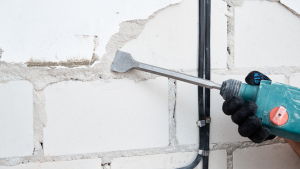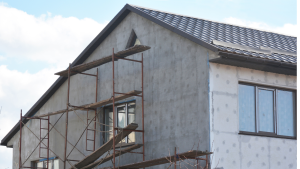Walls and other surfaces inside and outside structures are covered with standard brick stucco, a cement-based plaster. The basic components of this material, which dries to form a durable and low-maintenance construction, are cement, sand, and lime.
Stucco increases your property’s value since it uses less energy, requires less upkeep, and is fire and decay-resistant. Take care of your stucco walls, and fill up any gaps that develop over the wall.
HOW TO REPAIR STUCCO?
Caulk may be used to patch up hairline cracks or ones that are just a third to a fourth of an inch broad. Since latex resin is flexible enough to prevent the crack from spreading even as it expands, it is often utilized to make the caulk required to repair stucco.
Despite being one of the strongest wall coverings and construction materials available, stucco is prone to settling, impact damage, and cracking with time. Large stucco holes and cracks must be quickly repaired to stop future degradation.
Repairing the massive outside stucco holes is challenging. Perseverance and the appropriate tools are required. Your repair may not be as well done as a stucco repairer’s. However, you may always contact a stucco repair near me to do the task. This article looks at a few do-it-yourself methods for filling substantial stucco gaps.
STEP 1:
Bring any tools required to patch the stucco hole. A dust mask, gloves, and safety glasses are required.
STEP 2:
Corners need to be cleaned up first. Use a cold chisel and ball-peen hammer to remove the loose stucco from the hole. After that, blow the dust away.
STEP 3:
The untouched stucco around the patch area should have the old metal lath removed. It will be simpler to deal with if the strip is pulled back.
STEP 4:
Rubber membrane should be used to seal the outer border of the lath. The area is sealed off and may not adequately adhere to the rubber membrane. If so, you may improvise or use a few staples to hold it in place.
Instead of a rubber membrane, which was previously used because it is less costly, use a tube of polyurethane sealer.
STEP 5:
You must first cut a piece of double-D tar paper. Cut it to suit the exposed area of the route. The component must be fastened to the sheathing using a hammer and nails.
STEP 6:
Portland cement and luminite have to be prepared. Lay laminate over the mesh wire inserted into the hole, and then wait no more than ten (10) minutes.
STEP 7:
Then, apply it to the applied stuffing using a clean dash brush dampened with Portland cement. If you run too rapidly, the cement will sink drastically. Avoid dashing the luminite repeatedly, as this will also be subtle.
STEP 8:
Using a pattycake trowel, make designs on it and set it aside to dry. Paint the wall as it dries.
A stucco patch compound is necessary to repair larger cracks, chipped-out areas, and other problems. Before using this material, clean the patched area of any loose materials and cut V-grooves into the sidewalls of the crack.
After combining the patching compound by the instructions on the container, fill the hole or gap using a masonry float or trowel. Use a scoop for sanding the repaired area before setting the compound.
After the compound has cured, you may hide the repair by adding a separate layer of stucco patch and replicating the texture pattern using a comb or trowel.
FINAL THOUGHTS
Over time, cracks and holes in stucco may appear due to settling and impact damage. It’s crucial to choose a reputable stucco repair service nearby.




